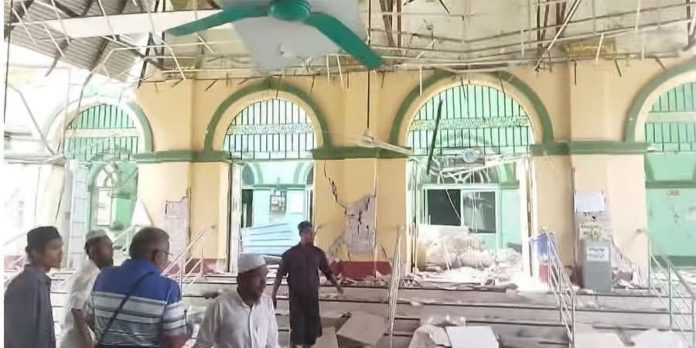Guest contributor
Harry Myo Lin
Two days after a devastating 7.7 magnitude earthquake struck central Myanmar, the scale of destruction and suffering is staggering—and still growing.
In Mandalay, nearly 450 Muslims have been confirmed dead, many of them crushed as they prayed in mosques during the sacred Friday prayer.
The actual death toll is feared to be much higher, with some local estimates suggesting over 1,000 Muslims alone may have perished and thousands more across the city and region.
The quake struck at the worst possible time—midday on the last Friday of Ramadan when mosques were filled with worshippers. Many of these religious buildings collapsed instantly.
Most had stood for decades, some even centuries, without any government-approved renovation or structural upgrade. Communities were long denied permission to reinforce their mosques, leaving them dangerously vulnerable—the result: a preventable mass loss of life.
Survivors and local leaders describe this as a grim consequence of decades of structural discrimination that turned sacred spaces into deadly ruins.
A network of youth volunteers—originally formed to respond to the COVID-19 crisis—attempted to reassemble and support rescue operations.
But more than 90 percent of these young people are no longer in Mandalay, having fled due to post-coup persecution or ongoing armed conflict. With them gone, the city’s volunteer response has been gutted at a time of critical need.
What’s left is a heartbreaking picture of ordinary people digging through rubble with bare hands. No state rescue teams have arrived. No heavy equipment. No organized response. Local rescue efforts are scattered, under-resourced, and overwhelmed.
Families plead for help, trying to reach loved ones trapped under collapsed buildings, many still alive. In some townships, volunteers reported hearing cries for help from beneath debris, but lacking tools or manpower to reach them.
Hospitals are damaged, overcrowded, or non-functional, with patients being treated on roadsides and in parking lots.
At the same time, Myanmar’s military junta continues to ignore civilian needs. Even on the day of the quake, they launched airstrikes in Karen State—a chilling reminder that war has not paused for this disaster.
People in Mandalay say there is no trust in the military to deliver aid, and many believe state-controlled channels will only delay or restrict help from reaching the most affected.
The destruction extends beyond human life. Over 150 religious buildings across the country—monasteries, mosques, pagodas, and churches—have been damaged or completely destroyed.
Historic and cultural landmarks like the Ava Bridge have collapsed. Iconic sites such as the Mahamuni Pagoda and Maha Aungmye Bonzan Monastery are heavily damaged or reduced to rubble.
In one case, 600 monks were trapped under a collapsed temple; at least 80 bodies have been recovered. These places were not just cultural treasures—they were shelters, gathering points, and homes.
In Mandalay, entire neighborhoods look like war zones. Local rescue teams, working non-stop, report body after body pulled from ruins.
A community-based group estimated the true death toll in the city could be between 5,000 to 100,000, though unverified, based on damage patterns and population density. Early models by global seismic experts predicted this possibility given Myanmar’s fragile infrastructure and dense urban areas.
This disaster hits a nation already reeling. Since the 2021 military coup, over 3.5 million people have been internally displaced, and much of the country lives under the fear of military violence.
The mental health toll was already severe—families living in fear, communities grieving disappeared loved ones, children growing up in conflict zones.
Now, the earthquake adds a crushing new trauma. People are sleeping outdoors, too afraid to re-enter their homes. Survivors describe living with constant aftershocks and uncertainty, afraid that any structure could come crashing down.
Immediate action is essential. Local responders need direct support—equipment, food, shelter, and medical supplies. The international community must not wait. Every hour counts.
The United Nations and the Association of Southeast Asian Nations (ASEAN) must launch urgent humanitarian missions, independent of the military, and facilitate aid routes directly to affected communities.
Trusting the military with aid distribution is not an option.
For those who want to help: donate directly to grassroots groups operating in Myanmar. These local networks are the only reliable lifeline for many. International agencies must act creatively and fast, finding ways to bypass political barriers.
This is not just about rebuilding; it is about survival. A generation already scarred by war is now buried in rubble. Without help, many more will be lost—not just to the earthquake, but to the silence that follows.
Harry Myo Lin is a Myanmar expert based in Austria with extensive experience across Myanmar and Asia, specialising in peacebuilding, International Relations, interreligious dialogue, and promoting freedom of religion and belief.
DVB publishes a diversity of opinions that does not reflect DVB editorial policy. We’d like to hear what you think about this or any of our stories: [email protected]



